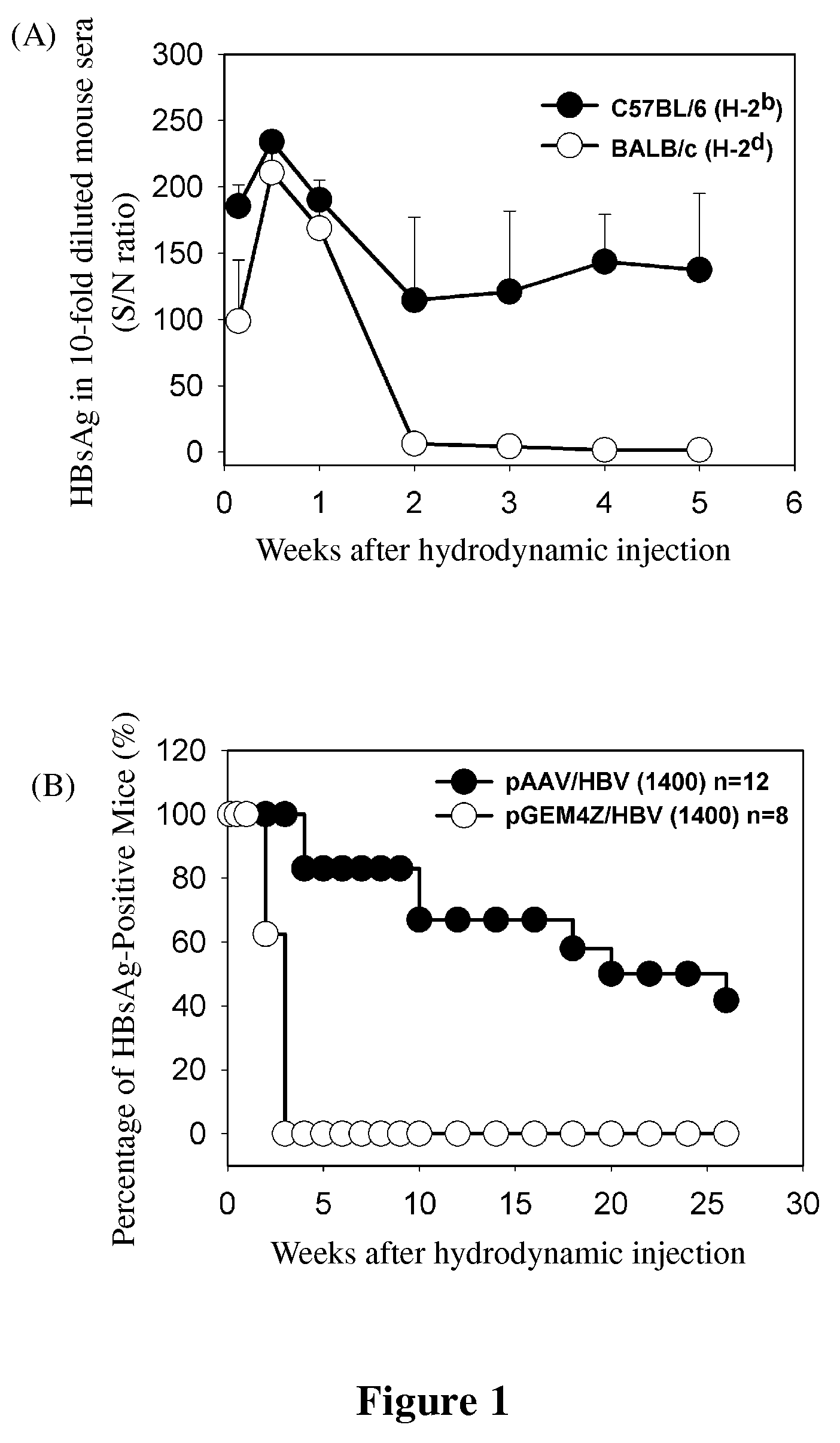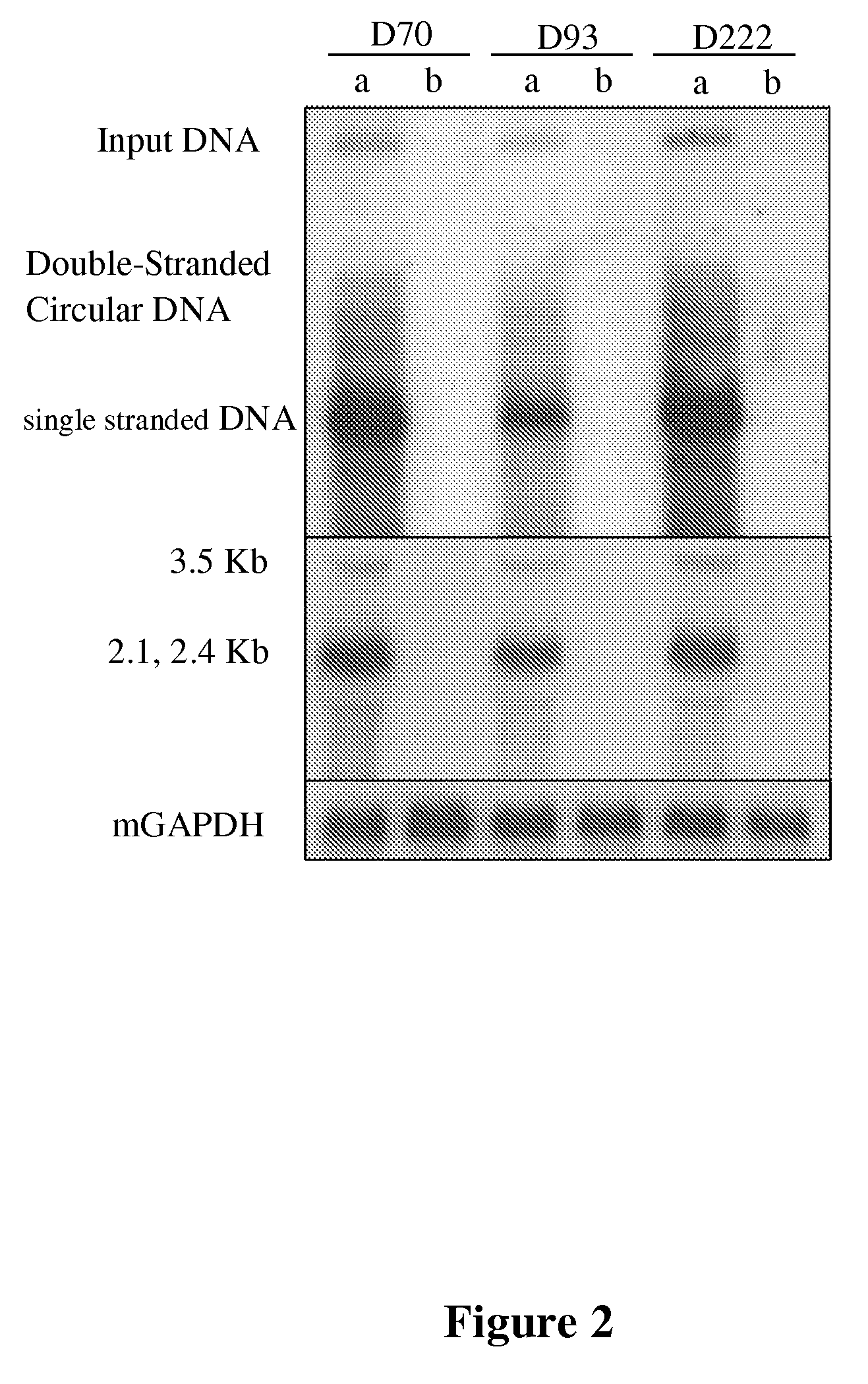Recombinant plasmid and method for expressing hepatitis B viral antigens and virions in vivo
a plasmid and hepatitis b technology, applied in the field of recombinant plasmids and methods for expressing hepatitis b viral antigens and virions in vivo, can solve the problems of different mechanisms of liver inflammation derived from such hbv transgenic mice, cell apotosis, and animal models are not ideal for studying hbv tolerance and clearan
- Summary
- Abstract
- Description
- Claims
- Application Information
AI Technical Summary
Benefits of technology
Problems solved by technology
Method used
Image
Examples
example 1
Construction of Vector
[0031]The HBV 1.2-full-length DNA is isolated from the plasmid pHBV-48, containing a greater-than-genome-length HBV fragment (subtype adw, gene type A) cloned in pGEM-3Z vector. The replication-competent HBV 1.2-full-length gemone replaced the GFP fragment in AAV-GFP vector by ligation of the BamHI / EcoRI (1.8 kb) and EcoRI / BglII (2.0 kb) fragments of pHBV-48 to the BglII site of AAV-GFP vector. The resulting pAAV / HBV (1400) contains the HBV fragment spanning from nucleotides 1400-3182 / 1-1987 flanked by inverted terminal repeats (ITRs) of AAV.
example 2
Transfection Procedure and Determination
[0032]In vivo experiment of the vector transfection, 6 to 8 weeks old male C57BL / 6 mice with H-2b haplotype are used as experimental group, whereas 6 to 8 weeks old male BALB / c with H-2d haplotype are selected as control group. Ten micrograms of the abovementioned HBV plasmid pAAV / HBV (1400) were injected into the tail vein of mice in a volume of phosphate-buffered saline (PBS) equivalent to 8% of the mouse body weight under hydrodynamic condition that is well known for those skilled in the art. The total volume is delivered within 5 seconds.
[0033]After injection, the mice are regularly bled to follow serum concentration of HBV surface antigen (HBsAg), anti-HBV core protein antibodies (anti-HBc) and anti-HBs antibodies (anti-HBs) at the indicated time points, using the AXSYM system kit (Abbott, GmbH Diagnostica). The livers of mice are preserved in optimal cutting temperature (OCT) for immunohistochemical analysis. Expression of HBcAg and HBsA...
example 3
[0036]The HBV expression cassette is excised by SmaI digestion (located inside of the two ITRs) from the pAAV / HBV (1400) and subcloned into SmaI site of pGEM4Z to result in pGEM4Z / HBV (1400). Then the obtained recombinant plasmid pGEM4Z / HBV (1400) is injected into the tail vein of C57BL / 6 mice according to the method described in example 2.
[0037]The results show that the injection of pGEM4Z / HBV (1400) into C57BL / 6 mice produced only transient surface antigenemia (shown in FIG. 1b) and all of them developed anti-HBs within 4 weeks (Table 1), suggesting that persistence of HBV in C57BL / 6 mice is associated with of injection of pAVV / HBV (1400) plasmid.
PUM
| Property | Measurement | Unit |
|---|---|---|
| viral surface | aaaaa | aaaaa |
| gel electrophoresis | aaaaa | aaaaa |
| fluorescent | aaaaa | aaaaa |
Abstract
Description
Claims
Application Information
 Login to View More
Login to View More - R&D
- Intellectual Property
- Life Sciences
- Materials
- Tech Scout
- Unparalleled Data Quality
- Higher Quality Content
- 60% Fewer Hallucinations
Browse by: Latest US Patents, China's latest patents, Technical Efficacy Thesaurus, Application Domain, Technology Topic, Popular Technical Reports.
© 2025 PatSnap. All rights reserved.Legal|Privacy policy|Modern Slavery Act Transparency Statement|Sitemap|About US| Contact US: help@patsnap.com



